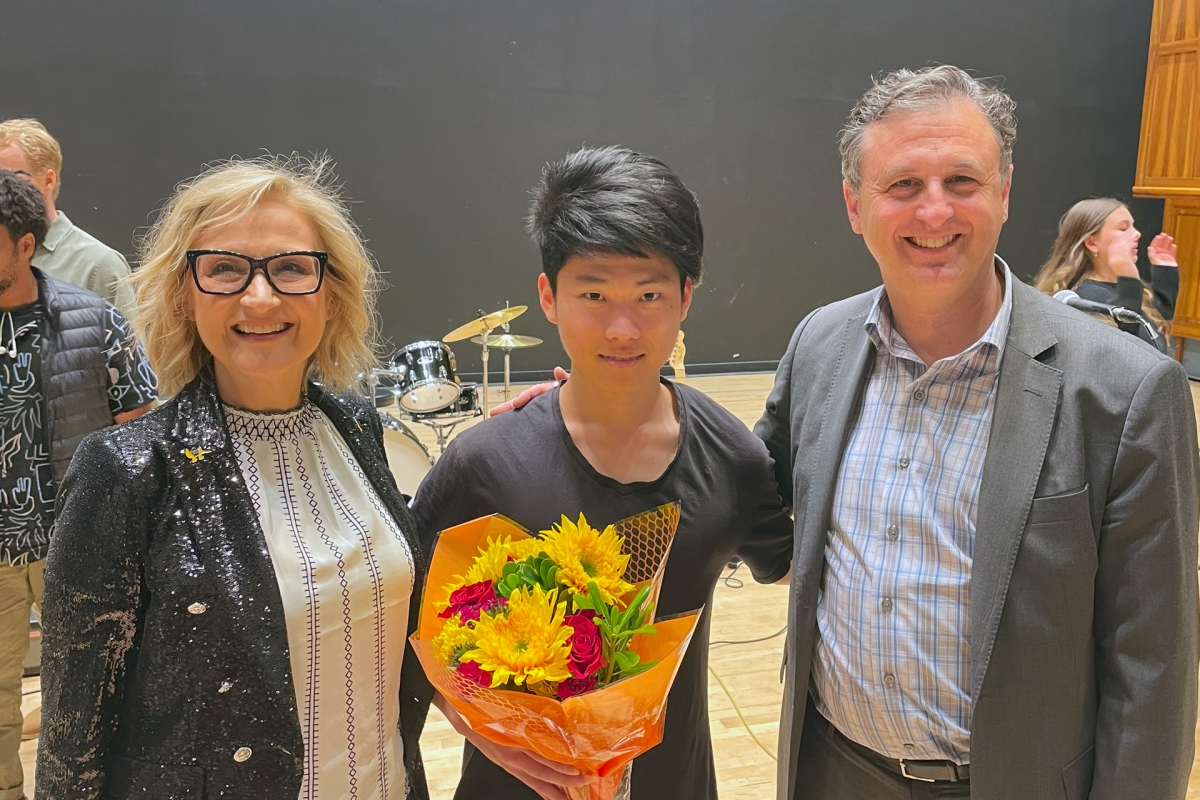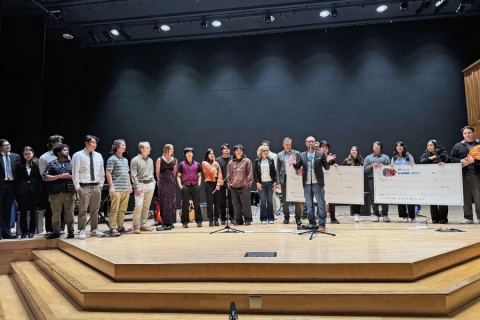The Creative Engine Behind E-SONIC
UC Irvine engineering and music students invent instruments in a competition that merges arts and technology
The Creophone, Wube Tubes, and Saxatars were just a few of the extraordinary creations showcased by Samueli School of Engineering students who tackled a unique challenge: invent a new musical instrument for a UCI contest. Their inspirations spanned from harnessing brainwaves to capturing the wind and upcycling instrument parts. This ingenious imaginative spirit was on full display at the first Engineering-Symphonic Orchestra New Instrument Competition (E-SONIC) on May 20, held at Winifred Smith Hall, Claire Trevor School of the Arts.
"This new instrument competition is all about having the courage to go after new and wild ideas," said Stacey Nicholas Dean of Engineering Magnus Egerstedt, who, together with Pacific Symphony President John Forsyte, conceived the contest. "I want our students to have creative confidence – the confidence to embrace a new problem or stand in front of an empty scoresheet and imagine something that didn’t exist before."
The Pacific Symphony welcomed these inventions with open minds, "The idea that there could be a new color or texture introduced to orchestral music through an invented instrument would be an amazing addition to our ability to create beautiful art," said Forsyte. Winners not only received cash prizes ($1,000 and $500) but also the chance to work with the Pacific Symphony to compose and perform a piece around their instrument.
Six teams of engineering students spent months designing and creating their musical inventions. The rules were simple: the instruments had to be new, playable with notes, and have some physical manifestation. Each team was guided by a faculty advisor, a hybrid engineer-musician, and earned academic credit for the project.
At E-SONIC, the teams explained the technology behind their designs and performed music with their instruments. The jury included experts from the Pacific Symphony, Claire Trevor School of the Arts, and the Samueli School of Engineering.
The six entries included three synthesizers. The Creophone, worn over the head, is an EEG-controlled synthesizer that detects specific brainwave thresholds to evoke music chords. Pulstar is an electronic synthesizer, while the May Organ is an amplified electromechanical instrument that merges concepts from the Hammond organ and digital wavetable synthesizers.
The Wube Tubes is a fusion of recycled wind and string instruments, played by blowing into the tubes while plucking the strings. The Saxatar, the winner of the People’s Choice Award, harnesses wind through the science of fluids and vibrations.
Taesung Hwang, a senior majoring in both computer engineering and music, created the jury’s top choice – the Inductus – which he affectionately calls a "cool big stick." The three-foot-long rod produces an extraordinary array of ethereal sounds as a magnet slides inside, passing through coils of wire that send electronic impulses to a microcontroller, transforming the signals into music. "There’s a deep connection between the arts and STEM fields," Hwang said. "We can use computer algorithms to generate melodies, harmonies and rhythms. It’s fun putting the two together."
Video: Taesung Hwang performs with his award winning instrument, the Inductus.
In addition to the debut of these novel instruments, the evening featured performances from a band comprised of Dean Egerstedt and four engineering faculty musicians. They rotated instruments as they performed engineering-themed tunes like “Another Brick in the Wall,” “Rocket Man” and “The Scientist.” The band included Pim Oomen (Biomedical Engineering), Herdeline Ardoña (Chemical and Biomolecular Engineering), Ali Mohraz (Chemical and Biomolecular Engineering) and Maxim Shcherbakov (Electrical Engineering and Computer Science), who also served as advisors to the student teams.
Claire Trevor School of the Arts Dean Tiffany Ana López was particularly impressed with the competition. "Complex challenges require multifaceted teams of thinkers who inspire and innovate, which is what the arts are about,” said López. “More than half of future careers will be ones our students invent, and this competition epitomizes how UCI students bring together critical and creative approaches to solve problems they may face with innovative bold solutions."
E-SONIC is now planned to be an annual event, with the hope that some of the instruments might be incorporated into works performed by the Pacific Symphony. “This is only the beginning,” said Egerstedt. “Next year will be bigger, shinier, with even more instruments.”
The success of the inaugural E-Sonic proved that when engineering meets art, the result is nothing short of extraordinary. The Claire Trevor School of the Arts, alongside its partners, showcased how interdisciplinary collaboration can lead to groundbreaking innovations and unforgettable performances. If you missed this year's event, make sure to mark your calendar for the next E-SONIC—you won’t want to miss the encore!


